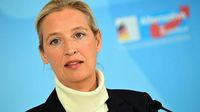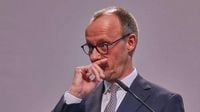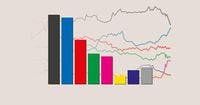In a startling shift in the political landscape of Germany, a recent RTL/ntv Trendbarometer poll has revealed that the Alternative for Germany (AfD) has surged ahead to become the strongest political force in the country, claiming 26 percent of voter support. This marks a significant change from the aftermath of the Bundestagswahl 2025 held on February 23, where the Union (CDU/CSU) emerged victorious but has since seen a decline in popularity.
According to the latest findings from the Forsa polling institute, the AfD gained two percentage points compared to the previous week, while the Union stagnated at 25 percent. Meanwhile, the Social Democratic Party (SPD) remains unchanged at 15 percent. The Green Party and the Left each lost one percentage point, now standing at 11 and 10 percent, respectively. The BSW and the Free Democratic Party (FDP) both sit at 4 percent, with other parties collectively garnering 6 percent of the vote.
Since the Bundestagswahl, the Union has lost four percentage points, while the AfD has gained five, showcasing a dramatic turnaround in voter sentiment. The trend indicates that the Union has been on a downward trajectory since November 2024, while the AfD continues to build momentum.
As the political dynamics shift, the Union and SPD are grappling with differing approaches to dealing with the AfD. Leading Social Democrats have expressed concern over proposals from Union officials, including Jens Spahn, who suggested treating the AfD as any other opposition party, including allowing them leadership roles in Bundestag committees. Bundestagspräsidentin Julia Klöckner from the CDU announced her intent to mediate in this ongoing dispute.
SPD-Generalsekretär Matthias Miersch has firmly stated his opposition to any AfD candidates taking on significant roles in parliamentary committees, emphasizing that he cannot support an individual from a party that systematically undermines democracy. "I cannot imagine electing a member of the AfD as chair of a Bundestag committee," Miersch told Bild, highlighting the tensions between the parties.
Ralf Stegner, a member of the SPD Bundestag, warned that any normalization of relations with the AfD could jeopardize potential coalition agreements between the Union and the SPD. He stated bluntly, "If conservatives want to normalize relations with the far-right AfD, they are lighting the fuse on a possible coalition with the Social Democrats."
The AfD's rise has been attributed to various factors, not least of which is the dissatisfaction among voters with the current ruling coalition, often referred to as the traffic light coalition due to its red-yellow-green color scheme. Many voters who previously supported the AfD cited their discontent with the government as a primary reason for their choice. In a recent survey, 24 percent of AfD voters indicated that their dissatisfaction with the traffic light government influenced their decision to support the party.
Additionally, 35 percent of AfD supporters align with the party's political views, while 19 percent expressed a general rejection of the political system altogether. Notably, 15 percent of voters indicated that their reservations about Friedrich Merz, the potential next Chancellor from the Union, played a role in their voting decision.
The polling data indicates that the AfD's potential voter base may exceed 30 percent of the electorate, with 12 percent of respondents who did not vote for the party in the last election expressing an openness to supporting them in the future. This sentiment is particularly strong in the eastern regions of Germany, where 18 percent of non-AfD voters are now considering the party.
The political climate is further complicated as the Union and SPD find themselves trailing behind their electoral results from February 24, 2025, by nearly five percentage points. This decline comes at a time when both parties have not yet fully engaged in governance, raising concerns about their ability to effectively lead.
Polling trends have shown that major institutes like Forsa and Infratest dimap regularly survey voters to gauge their party preferences. The RedaktionsNetzwerk Deutschland (RND) compiles daily averages from the last ten polls, providing a clearer picture of shifting political allegiances.
Historically, the SPD was the leading party in polls following the 2021 Bundestag election but was soon overtaken by the Union. The Greens experienced a similar trajectory, initially rising in popularity but later losing substantial support. The FDP, meanwhile, failed to clear the 5 percent threshold in the 2025 election, a significant setback for the party.
As the AfD continues to gain traction, the implications for German politics are profound. The party's ascent raises questions about the future of traditional coalitions and the potential for a more fragmented political landscape. The ongoing debates about how to engage with the AfD will likely shape the strategies of both the Union and the SPD in the coming months.
In summary, the AfD's rise to prominence reflects a broader discontent with the current political establishment and signals potential shifts in voter behavior as the country moves forward. With the upcoming political challenges and the need for effective governance, the responses of the Union and SPD to the AfD will be critical in determining their future viability.






